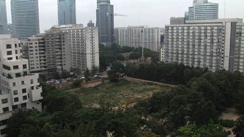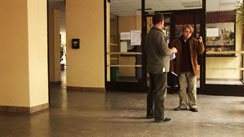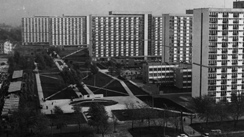Home / / Photo / Sculptures / Curatorial Projects / Bio / Contact
![]()

![]()

![]()

![]()
> stills and quotes
![]() > view excerpt
> view excerpt
![]() "... A home is not only the place we experience in the practice of everyday life or where we want to feel at ease and safe. A home is also the place that forms our desires and views, family and social ties. One of the aims adopted by architects of modernistic estates – although now this seems far from reality – was providing a safe and dignified shelter. Heidrun Holzfeind’s film Za Zelazna Brama raises however a new question regarding inhabitance: can one feel at home in a post-socialistic architectural environment defined by unfamiliar buildings.” (Gabriela Switek)
"... A home is not only the place we experience in the practice of everyday life or where we want to feel at ease and safe. A home is also the place that forms our desires and views, family and social ties. One of the aims adopted by architects of modernistic estates – although now this seems far from reality – was providing a safe and dignified shelter. Heidrun Holzfeind’s film Za Zelazna Brama raises however a new question regarding inhabitance: can one feel at home in a post-socialistic architectural environment defined by unfamiliar buildings.” (Gabriela Switek)
read full text in > English
"... Zelazna Brama, which still functions in public consciousness as a symbol of the crimes committed on the city by communists and modernists, is now a completely different place. We see in the film how the modernistic template is filled in with new substance, and the quality of life offered by it is not that bad after all. Liberal capitalism that breathed new life into the old structure turned out to be a double agent. The free market sale of land resulted in the building up of the spaces between the blocks. In many places, the new lines of development run where the participants of the Architectural Confrontations, from the Communist times, wanted them to be. The invasion of developers distorted the composition of the estate, but at the same time connected it with the rest of the city centre and raised its functional diversity. Office buildings, hotels and restaurants appeared next to blocks, schools and local shops. All this caused Zelazna Brama to become a place, maybe not as quiet as before, but definitely more interesting to live in...” (Grzegorz Piatek)
read full text in > English
"Za Zelazna Brama was built between 1965 and 1972 on the ruins of the so-called Small Ghetto in Warsaw. The original plan, clearly rationalist in concept, called for the construction of 19 blocks, each 16 storeys high, of small flats. Although as an estate initially functional, it has now become a peculiar periphery on the edge of downtown Warsaw. Over time the buildings have decayed and their occupants are now mostly pensioners, students and a large Vietnamese community. Holzfeind's work documents these changes through a documentary approach to the interiors and the broken-down society of the blocks. As in Kieslowski's celebrated Ten Commandments, housing blocks serve as a framework-setting for an approach to the real people who occupy them and to their imaginaries in conflict with a daily existence of survival.
Rationalist housing estates, wether in Marseilles or in the former communist countries, represent the paradigm of the concept of inhabiting as a form of social discipline which eventually resulted in peripheries that have become fetishes of late capitalism. But in the Soviet-bloc countries, this solution – osiedle [Osiedle (solution) is also what large housing estates are called in Poland) sought to articulate an urban model for a working class which, under this same discipline was meant to lead social transformation, a fact which heightens the aura of failure now surrounding these bedroom cities. Za Zelazna Brama today is another example of a place easily stigmatised which, despite not suffering the violence that erupted in the French banlieues, is barely able to sustain a damaged community life, and which even as a social and political question is reduced to a simple geographic parameter: suburb. Holzfeind's work compiles the thoughts of residents of the place who talk explicitly and openly of the problems of adapting today to these modern housing types that sought to change life. After the architecture, residents, regardless of their identity, speak out against the lack of comforts of the interiors and the poverty of social life that inhabits the environs.” (Martí Peran in: After Architecture. Typologies of the Afterwards)
-